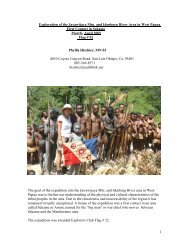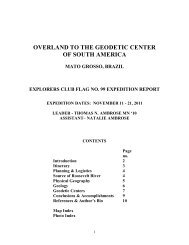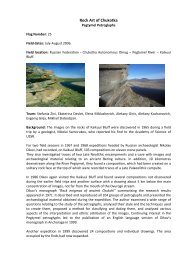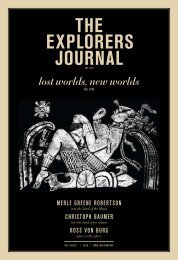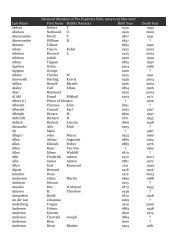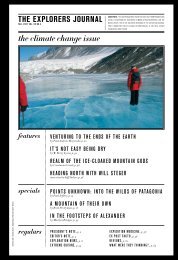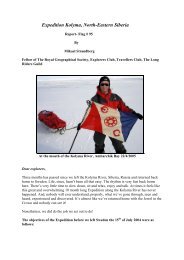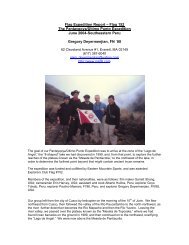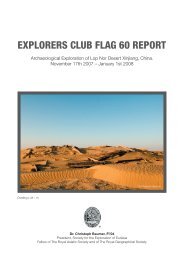Expedition INCA ORACLES - Peru and Boliwia - The Explorers Club
Expedition INCA ORACLES - Peru and Boliwia - The Explorers Club
Expedition INCA ORACLES - Peru and Boliwia - The Explorers Club
Create successful ePaper yourself
Turn your PDF publications into a flip-book with our unique Google optimized e-Paper software.
<strong>Expedition</strong> <strong>INCA</strong> <strong>ORACLES</strong> - <strong>Peru</strong> <strong>and</strong> <strong>Boliwia</strong>June - July 2007Report # Flag 160ByPh D Mariusz Ziolkowski (FI 2002) - Director of the Center of <strong>The</strong> PrecolumbianStudies of Warsaw University; Leader of the “Project Condesuyos”Monika Rogozinska (FI 1993) – JournalistMariusz Ziolkowski with Monika Rogozinska on Suriqui Isl<strong>and</strong>Incas <strong>and</strong> pre-Incas sites<strong>Peru</strong>:• Maucallacta, 3600-3800 m above the sea level (massive of CoropunaVolcano 6425 m),• Allisyuo, 3600 m (massive of SolimanaVolcano 6093 m)• <strong>The</strong> mummy in a grotto of Pumahuillca at 4820 m - the last worshippedmummy in this part of <strong>Peru</strong>.<strong>Boliwia</strong>:• Inca Uta - the sanctuary on Suriqui Isl<strong>and</strong> on Lake Titicaca devoted tothe cult of the Sun
Map: A network of Inca sites examined by Polish <strong>and</strong> <strong>Peru</strong>vian archaeologists from theCondesuyos Project.Main purpose of the Project CondesuyosPolish-<strong>Peru</strong>vian archaeological mission has found in the <strong>Peru</strong>vian Andes thelargest administrative <strong>and</strong> religious center, <strong>and</strong> at the same time the mostimportant oracle of the Condesyuos - one of the four parts or districts of theInca Empire (known in the Quechua language as Tahuantinsuyo, that is FourParts [of the world] Taken Together).<strong>The</strong> oracle Maucallacta, “Old Settlement” in Quechua language, has circa250 buildings, tombs <strong>and</strong> stone platforms. It lies in the massif of thesnowcapped Coropuna volcano, an hour drive by car from the present-daytown of Pampacolca (2900 m) <strong>and</strong> 10 hours drive from Arequipa. <strong>The</strong> roadcrosses steep slopes of picturesque valleys <strong>and</strong> is mostly unpaved.
CoropunaCredit: Monika RogozinskaIt was known from the colonial chronicles, that the Coropuna played animportant role here.<strong>The</strong> mighty <strong>and</strong> snow capped massif was believed at the beginning of the 20 thc. to be the highest peak of the South America. It was Hiram Bingham, thediscoverer of Machu Picchu, who climbed one of its summits <strong>and</strong> made moreproper measurements. (Today we can find two measurements of its highestpoint: 6377 m <strong>and</strong> 6425 m). Nevado Coropuna is undoubtedly the highest <strong>and</strong>largest volcano in <strong>Peru</strong>. It is located about 150 km northwest of Arequipa.<strong>The</strong> 16 th c. chronicles mentioned that Coropuna-holy mountain, was a keycultic centre of the Incas, a place where an oracle was open throughout thewhole year. <strong>The</strong> sanctuary enjoyed great prestige among the indigenouspeople <strong>and</strong> attracted crowds of pilgrims. <strong>The</strong> Incas visited it to get prophesies.Finding this oracle was the main aim of the Condesuyos Project.<strong>The</strong> project has been led for 11 years by Mariusz Ziolkowski together with<strong>Peru</strong>vian archaeologist Dr Luis Augusto Belan Franco, professor of the CatholicUniversity of Santa Maria in Arequipa. <strong>The</strong> Polish-<strong>Peru</strong>vian archaeologicalmission has worked along with the specialists from Spain, Germany, France,Netherl<strong>and</strong>s <strong>and</strong> Argentina. In 2006 volunteers from the Earthwatch Institutetook part in the excavations.
Maucallacta a unique placeMost of the buildings of Maucallacta are within a 30 hectare area. <strong>The</strong> centralpart of the ruins is on a hill that is crisscrossed with stony terraces, which afforda magnificent, panoramic view across the snow-covered summits ofCoropuna <strong>and</strong> the mouth of the Colca Canyon.Buildings bare the signs of provincial Incan architecture. <strong>The</strong>y are made ofstones bound with clay mortar. (<strong>The</strong>re are no carefully hewn stone blocks,typical for the architecture of Cuzco - the capital of the Inca Empire). <strong>The</strong> hillis surrounded by three burial grounds.A pyramidal platform towers above Macuallacta. It was raised on the top ofa hill <strong>and</strong> shaped like a flattened pyramid (reminiscent of one the summits ofthe Coropuna volcano). <strong>The</strong> largest man made stone <strong>and</strong> earth platformcould easily accommodate 5000 people. On its edge, the archaeologistshave unearthed remains of ushnu – dais for the priest <strong>and</strong> the dignitaries.At the base of the platform, the archaeologists found two dump sites withashes <strong>and</strong> animal bones, pieces of ceramics <strong>and</strong> items made of metal <strong>and</strong>ivory, which were sacrificed to the God of Coropuna Volcano by burning onpyres.MaucallactaCredit: Krystian BielatowiczDuring the Flag <strong>Expedition</strong> monumental stairs, which were the entrance to themain platform, were uncovered from beneath the ashes. <strong>The</strong> examination ofashes <strong>and</strong> layers of remains allowed the archaeologists to reconstruct thecourse of sacrificial ceremonies.It also indicates that Maucallacta was a holy place hundreds of years beforethe arrival of the Incas.
We can tell that the site is truly a unique place. In 2007 in the months of June<strong>and</strong> July alone, the expedition excavated about a ton of shards <strong>and</strong> ceramicIncan vessels shattered in sacrifice. It also found an ivory hair comb that wasused 500 years ago for last time.All the items found in Maucallacta are placed in the Archaeological Museumof the Catholic University of Santa Maria in Arequipa.Mariusz Ziolkowski in one of the tombs of MaucallactaCredit: Monika RogozinskaA building named Mausoleum in the center of the sanctuary, housedmummies, however, the degree of destruction allows only to suspect that justabout two to three important people of Maucallacta were laid there. In frontof the Mausoleum chamber, there is a vestibule, in which offerings weregiven. <strong>The</strong>re are also human remains buried deeper under the altar forofferings.In the upper parts of the Coropuna volcano no children sacrifices have beenfound so far, although, from the illustrations of the Indian chronicler, GuamanPoma de Ayala, we know that they were made. It is not an easy task though,since a permanent ice cap of about 130 square kilometres covers the hills ofCoropuna. Some remains have already been found on other volcanoes inthe vicinity: on Sara Sara, Misti <strong>and</strong> Ampato where Dr John Reinhard found afrozen Incan sacrifice – a girl named after him “Juanita”.
Mission possible<strong>The</strong> scientists are fulfilling another important mission.<strong>The</strong> Condesuyos is an interesting, sparsely populated, impoverished <strong>and</strong>beautiful region. Polish archaeologists have penetrated the area of about 2.5thous<strong>and</strong> square kilometers up to the glacier line - 5500 m, in order to localize<strong>and</strong> document the network of Inca settlements, <strong>and</strong> religious centers,organized at the turn of the 16 th c., such as: Coropuna Plaza (4600 m) <strong>and</strong>Quimsa Huanca (4150 m) on the southern slopes of Coropuna<strong>The</strong> area has not yet been opened to the tourists. Archaeologists whoexamine <strong>and</strong> restore the buildings, are working on making the historic sitesopen to the public, which might improve the economical situation of this poorregion of <strong>Peru</strong>.A good example is what happened after the exploration of the ColcaCanyon in 1981. Polish canoeists from the CANOANDES expedition, who forthe first time traveled the virgin canyon, devoted themselves to the promotionof the region <strong>and</strong> consequently the Cocla Valley became the most popular<strong>and</strong> most profitable tourist attraction site in <strong>Peru</strong>, after Machu Picchu.In the 2007 season, archaeologists were uncovering Maucallacta buildingsfrom bushes <strong>and</strong> rubble that covers the walls <strong>and</strong> began setting tourist trails.<strong>The</strong> work is supervised by a Polish archaeologist Maciej Sobczyk <strong>and</strong> a<strong>Peru</strong>vian architect, restorer <strong>and</strong> archaeologist Gonzalo Presbitero Rodriguez,who was twice on a scholarship from the Polish Government, learning themethods of the famous ”Polish school of art preservation”.Conservation Project protects Acchaymarca - the Inca site on the west side of CoropunaCredit: Monika Rogozinska
To convince local people that ruins can be attractive to tourists the PolishChapter of <strong>The</strong> <strong>Explorers</strong> <strong>Club</strong> organized the first trip to Maucallacta. MonikaRogozinska guided a group of tourists from Pol<strong>and</strong>.May this inauguration of the “the tourist traffic” help convince localhighl<strong>and</strong>ers to protect the ruins <strong>and</strong> to invest in tourist infrastructure. <strong>The</strong> firsthostel in Pampacolca was built for the archaeologists so that they could havea base camp.Chatting with women in SalamancaCredit: Monika RogozinskaHospitable local people in PampacolcaCredit: Monika Rogozinska
Puyas Raymondi, very rare, gigantic plants, grow at 4000-4200 m. <strong>The</strong>yblossom once per hundred years resembling a 12 m column littered with 20thous<strong>and</strong>s flowers <strong>and</strong> then die. <strong>The</strong>re is no mention of this place in the travelguides as well as of unused hot springs in the vicinity of Maucallacta.Puya Raymondi shedding blossoms on the slopes of the Coropuna VolcanoPuya RaimondiCredit: Monika Rogozinska
Found on the slopes of SolimanaOn the 10 th of July 2007, after a 10 hour horse ride through steep paths of theRio Arma valley, archaeologists encountered a completely new <strong>and</strong>unknown ceremonial complex, related to the cult of the God of Solimanavolcano. Allisuyo, is a group of about 100 buildings, over a dozen squares <strong>and</strong>tombs <strong>and</strong> a pyramidal platform towering over them all. It was a formersettlement exp<strong>and</strong>ed by the Incas.Mariusz Ziolkowski <strong>and</strong> Maciej Sobczyk while discovering the new Inca site - AllisyuoCredit: Krystian BielatowiczIn 2003 they also discovered the Minticocha pilgrimage center (4760 m), withthe highest situated kallanka structure (pilgrims house with many entrances)ever to be recorded. It was probably one of the main places of worship of theSolimana volcano in the Pre-Hispanic era.In the next year they found Queyo (3600 m), mentioned in chronicles asCanjirca – another place where the God of Solimana was worshipped.All those important locations, previously unknown to the scientific society,constitute the map of the Inca administrative <strong>and</strong> religious authority over theirterritory.
Worshipped mummyEight hours by car from Maucallacta by the unpaved road <strong>and</strong> then throughwilderness, from the west side of Coropuna, lies Pumahuillca, a mountain withflat summit surrounded by small lakes. After an hour of hiking a herdsman ledus to the last worshipped mummy in this part of <strong>Peru</strong>.MummyCredit: Monika RogozinskaIt is situated in a grotto on the hillside of Pumahuillca at 4820 m. <strong>The</strong> localshepherds treat the mummy as the patron of herds of lamas. In the past theyoffered coca leaves <strong>and</strong> corn beer – chicha as a sacrifice. Some of the items<strong>and</strong> ceramic vessels were offered 500 years ago, in the Pre-Columbian times.Now, we found a bottle after Inca-cola filled with rotgut. We made anoffering of rum, sweets <strong>and</strong> biscuits.
Inca Uta on Suriqui Isl<strong>and</strong> on Lake TiticacaBoliviaLake Titicaca <strong>and</strong> Suriqui Isl<strong>and</strong>Credit: Google maps800 km from Maucallacta begins Lake Titicaca. On the Suriqui Isl<strong>and</strong> there isInca Uta – a sanctuary devoted to the cult of the Sun. So far it has beenknown from a brief, unpublished research carried out by Bolivianarchaeologists in 1982. <strong>The</strong> researchers, however, did not examine the mostinteresting aspect of the site, which is the direct vicinity of the sacred rock<strong>and</strong> the ceremonial square in front of it. A small recess is hewn out in the rock:most likely a place for an idol. <strong>The</strong> recess is turned to the East so that it isilluminated by the morning sunrays.Although this part of the sanctuary has not been uncovered, the evidenceshows that it was a special place. What surprises, are two perfectly chiseledpolygonal blocks in front of the recess. Such exquisite stonework has not beenrecorded even in the sanctuary on the famous Isl<strong>and</strong> of the Sun on LakeTiticaca. Maybe, the answer to this mystery lies a few hundred years beforeIncas is in the Tiahuanaco State, whose capital of the same name, waslocated 22 km away from Lake Titicaca (currently in Bolivia). On theneighbouring Pariti Isl<strong>and</strong>, a Finnish-Bolivian expedition discovered in 2004 anenormous offering of beautiful vessels belonging to the Tiahuanaco culture. Isit that Inca Uta is in fact a Tiahuanaco temple? Future seasons of research willanswer this question.
Presentation of expedition resultsMonika Rogozinska <strong>and</strong> Krystian Bielatowicz prepared an illustrated articletitled “Sacred Andes”, for National Geographic Pol<strong>and</strong>, which is due in April2008.We cannot, however, enclose any of the breathtaking photos in the FlagReport as they are copyrighted <strong>and</strong> reserved for the publication in NationalGeographic Pol<strong>and</strong> <strong>and</strong> for the exhibition.<strong>The</strong> “Sacred Andes” exhibition is prepared by the Polish Chapter of <strong>The</strong><strong>Explorers</strong> <strong>Club</strong> together with National Geographic Pol<strong>and</strong>, Centre of thePrecolumbian Studies of Warsaw University, Ministry of Foreign Affairs underthe Patronage of UNESCO, “Rzeczpospolita” Polish Daily, TVP Polish Television<strong>and</strong> Polish Radio.<strong>The</strong> exhibition will take place:In the United States of America:- Consulate General of the Republic of Pol<strong>and</strong> in New York 13 th -15 th March,2008 during the <strong>Explorers</strong> <strong>Club</strong> annual meetings;In South America:- Lima, within the framework of the V th European Union-Latin America <strong>and</strong>Caribbean (EU-LAC) Summit at the level of Heads of State <strong>and</strong> Government(April <strong>and</strong> May 2008), in the Cultural Centre of the Ministry of Foreign Affairs of<strong>Peru</strong>, at the University of Lima, University San Ignacio Loyola <strong>and</strong> the PacificoUniversity.And later in:: Trujillo <strong>and</strong> Arequipa (<strong>Peru</strong>),: La Paz <strong>and</strong> Santa Cruz (Bolivia);: Quito, Guayaquil i Cuenca (Ecuador);In Pol<strong>and</strong>:- Warszawa, Poznan, Torun, Krakow, Gdansk, Suwalki <strong>and</strong> other cities.Members of the <strong>Expedition</strong><strong>Expedition</strong> <strong>and</strong> Project leaderMariusz Ziolkowski, Ph.D archaeologist, Director of the Project, Member of <strong>The</strong><strong>Explorers</strong> <strong>Club</strong> - FI’2002Address: Center for Precolumbian Studies, Warsaw University, KrakowskiePrzedmiescie 26/28, 00-927 Warszawa, Pol<strong>and</strong>e- mail: mziolkowski@uw.edu.plMonika Rogozinska, MA, journalist, Secretary of the Polish Chapter of <strong>The</strong><strong>Explorers</strong> <strong>Club</strong> - FI’1993, Consultant for the Special Project of the NationalGeographic Pol<strong>and</strong>02-645 Warszawa, Mahatmy G<strong>and</strong>hiego 19 m. 39, Pol<strong>and</strong>,Phone/fax: +48 22 8484630;e-mail: M.Rogozinska@rp.pl
Krystian Bielatowicz, MA, archaeologist <strong>and</strong> photographer, Pol<strong>and</strong>Gonzalo Presbitero Rodriguez, MA, architect-restorer – Co-Director of theCoservation Project (<strong>Peru</strong>)Maciej Sobczyk, MA, archaeologist – Co-Director of the Conservation Project(Pol<strong>and</strong>)Janusz Woloszyn, Ph.D., archaeologist (Pol<strong>and</strong>)Pawel Buda, M.A., archaeologist (Pol<strong>and</strong>)Arjan Mossel, BA, linguist, anthropologists (Holl<strong>and</strong>)Students of the Institute of Archaeology of Warsaw University (Pol<strong>and</strong>):Karolina Kowalska, 2nd yearIzabela Kosewska, 2nd yearZofia Zakrzewska, 4th yearPaulina Komar, 5th yearMaciej Marciniak, 5th yearKrzysztof Kotlarski, 3rd yearCredit: Krystian BielatowiczTHE END



